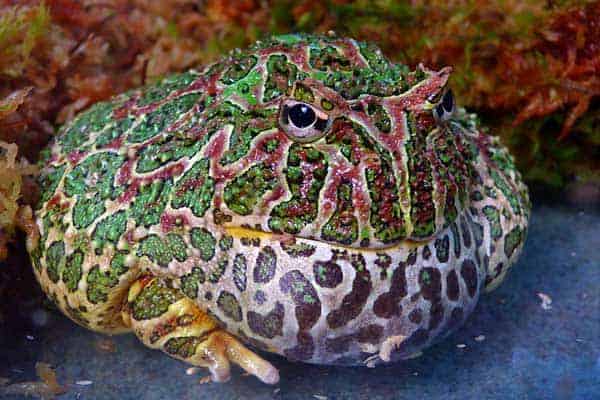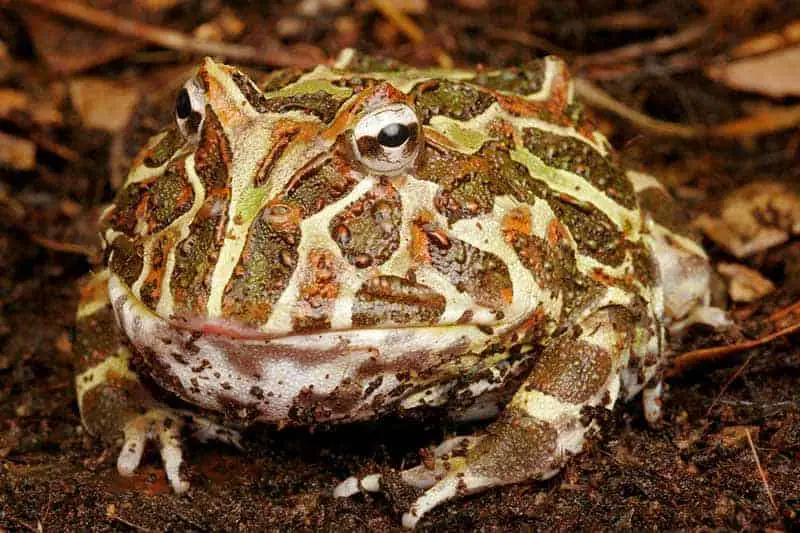Ever wondered, are frogs good pets? Well, how about the fascinating Pacman frog? These cool little critters could be your next delightful companion in the world of pet frogs!
Pacman frogs are colorful, non-poisonous frogs native to South America. Their wide mouth and round body resemble the 1980s arcade game Pacman, giving them their name. These frogs are also known as horned frogs due to the distinctive horn-like feature above their eyes. There are many reasons why Pacman frogs are good pets and have become popular for first-time amphibian owners.
They are low maintenance, aren’t fussy eaters, and have a low risk of escape. They also prefer not to be handled due to their sensitive skin and are best living alone, so you don’t need to own two frogs to keep them company.
These frogs are usually as wide as they are long and can grow an average of 6-inches long, with females larger than males. However, some species of Pacman frogs, such as the Surinam horned frog, can grow up to 7.9 inches in length. You can expect them to live five years as a pet. Although some can live up to 10 or 15 years!
So, is a Pacman frog the best match as a pet for you? Let’s find out.
Are Pacman Frogs Good Pets?
Pacman frogs are easy to care for, making them great pets for beginner amphibian owners. They are interesting pets that prefer not to be handled, so you don’t have to worry about having to interact with them frequently.
Do Pacman Frogs Bite?
Since Pacman frogs are one of the few frogs with teeth, yes, they can bite! They use biting as their defense mechanism when they feel threatened. However, sometimes they can simply mistake your finger or hand for food and bite. So, be careful when you are handling them and when small children are around them.
These frogs have strong jaws, so the bite can draw blood, but it’s not extremely painful. They usually let go immediately. However, they do have the strength to hold on, so it’s best to wear gloves when you are feeding or handling them.
Are Pacman Frogs Poisonous?
No, Pacman frogs are not poisonous. Their skin does not secrete toxins nor are their bites toxic. However, their skin is very thin, so they can easily absorb toxins and be harmed simply by being handled. This is why they are prone to biting to protect themselves.
Can Pacman Frogs Live Together?
Pacman frogs prefer a solitary environment with hiding spots, suitable temperatures, and humidity levels for optimal well-being. It is recommended to keep them individually to prevent conflicts and ensure their overall health.
Why Pacman Frogs Make Great Pets – 5 Reasons
For more details on why Pacman frogs make good pets, even for first-time amphibian owners, here’s a list of the top 5 reasons.
1. They’re quite eye-catching

These frogs are eye-catching, beautifully colored, and funny to look at, making them interesting pets to have. They have horns over their eyes, brown splotches, and colors ranging from bright green and yellow to apricot, albino, and strawberry.
2. Low-Risk of Escape
Pacman frogs are inactive and don’t like to climb, so you don’t need a large or tall tank. A screen top is sufficient as they prefer to burrow and spend time engulfed in soil. Since they also don’t jump as much as other frog species, you also don’t have to worry about them jumping away when you handle them.
3. No Noise or Smell
Unlike most frogs, they are generally silent pets and don’t make noises throughout the night. Pacman frogs also don’t emit much of an odor. The only smell you may sense is from dead insects or a dirty tank, which you can clean out easily.
4. Easy to Feed
As some of the only frogs with teeth, Pacman frogs will eat almost anything that moves near them. Since they aren’t fussy eaters, they are very easy to feed, but be careful if they bite you! When I had my pacman frog it often thought anything entering it’s tank was food!
5. Docile with Proper Care
Although Pacman frogs in the wild are known to have aggressive attitudes, these inactive frogs can be docile pets when they don’t feel threatened. Feed them, provide the right environment, and give them space with minimal handling to keep them happy.
12 Things You’ll Need to Own a Pacman Frog
So, how do you take care of a Pacman frog? What do you need? And why do you need them? Here is a list of 12 of the essential items.
1. Live Food
Pacman frogs aren’t fussy eaters, except they need live food. You can feed small frogs waxworms, silkworms, mealworms, and crickets. Medium or full-grown frogs also enjoy mice and small rats every two or three days.
It’s best to feed them in the evenings and only enough that they can eat over one night. Also, you should dust the insects with Vitamin D and calcium powder every other day for the added vitamins Pacman frogs need.
2. A Proper-Sized Tank
Adult pacman frogs need at least a 10-gallon terrarium to live comfortably. However, a 20-gallon tank, preferably measuring 30 x 12 x 12 inches is preferred. Tanks can be plastic or glass with a tight-fitting screen lid. You can also cover part of the cover in plastic to keep in moisture.
Something like this 5 gallon terrarium from Exo Terra would be perfect for a young Pacman frog. You can upgrade to a larger tank as your pet grows in size.
Note: Do not house more than one Pacman frog per tank, since they can be aggressive towards each other.
3. Enough Substrate
These frogs spend most of their time buried up to their eyes and hiding for prey to pass. You must line the bottom of your tank with enough substrate deep enough to cover the entire frog.
Usually, 2 to 4 inches is enough. Try to use a substrate that is moisture-capturing. Examples of suitable substrates include organic potting soil, bark bedding, coconut soil, peat moss, or sphagnum moss. Change this substrate bedding at least once a month.
4. A Water Bowl
Pacman frogs don’t drink water. Instead, they absorb the moisture they need through their skin. Place a bowl of chlorine-free, neutral pH water buried into the substrate so your pet frog can easily walk into it. Ensure the bowl is large enough for the frog but also shallow, since these frogs can’t swim and can easily drown.
Something like this one on Amazon is popular for pacman frogs.
5. Thermometer Hygrometer
The tank environment needs to stay damp and humid at all times or your Pacman frog will become dehydrated. If you have a digital thermometer hygrometer, it can help you monitor and regulate humidity in the tank. The tank should remain between 60% and 70% humidity. Look for something like this one.
6. Products to Humidify Tanks
As explained above, the tank needs to remain at a certain level of humidity. Products you can buy to easily mist and increase the humidity in takes include spray bottles or fogger systems. You can also cover part of the tank with plastic to trap moisture inside.
7. Live Plants
Having plants throughout the tank provides two main benefits. They give the frog another option to hide under and help maintain humidity levels in the tank. Safe plants for Pacman frogs are generally slow-growing, tropical plants suitable for high moisture environments, such as:
- Small ferns like microsorum scolopendrium
- Vines like epipremnum aureum ‘Neon’ Pothos
- Palms like chamaedorea elegans
- Trailing plants like the flame violet plant
8. Thermostat
These frogs can’t regulate their body temperature and need a consistent 65 to 85 degrees Fahrenheit to live comfortably. A thermostat will help you monitor the temperature inside the Pacman frog’s tank. Something like this will do just fine.
9. Reptile Heat Mat
A reptile heat mat helps warm up the tank, especially if you live in colder climates. However, make sure to place it on the side of the tank. This position can prevent dehumidification and your Pacman frog from overheating when burrowing too close to the heat mat.
Something like this should work fine for a pacman frog.
10. Light Bulbs
Pacman frogs are nocturnal and don’t need sunlight to survive. It’s actually best to avoid direct sunlight to prevent them from overheating. However, they do need a day and night cycle.
Use fluorescent bulbs or broad-spectrum lighting to give your frog between 10-12 hours of light per day. Avoid providing them with too much daylight or they might become stressed and refuse to eat.
11. Protective Gloves
Gloves are useful when you feed and handle Pacman frogs. It can prevent you from having a cut if they accidentally bite you. Since their skin is also very sensitive, it prevents you from transferring your hand oils or chemicals from lotions and soaps to them.
12. Cave Structures
Although not required, your Pacman frog can enjoy a cave-like structure as an additional hiding option. You can create these structures from branches or purchase smooth or cork-bark caves for reptiles. Make sure it is roomy enough for your Pacman frog to navigate, as they can be clumsy in cramped spaces.
Here’s an example of a hide for reptiles and amphibians found on Amazon.
Conclusion
Pacman frogs are wonderful pets for many reasons. They are especially great if you want a low-maintenance pet that’s not noisy and can easily fit in the corner of your house or apartment.
However, if you prefer active frogs you can handle and are safe around small children, the Pacman frog may not be the best match as your family pet. Also, since they can live over 10 years, make sure you are committed to having a pet for that significant period of time.





